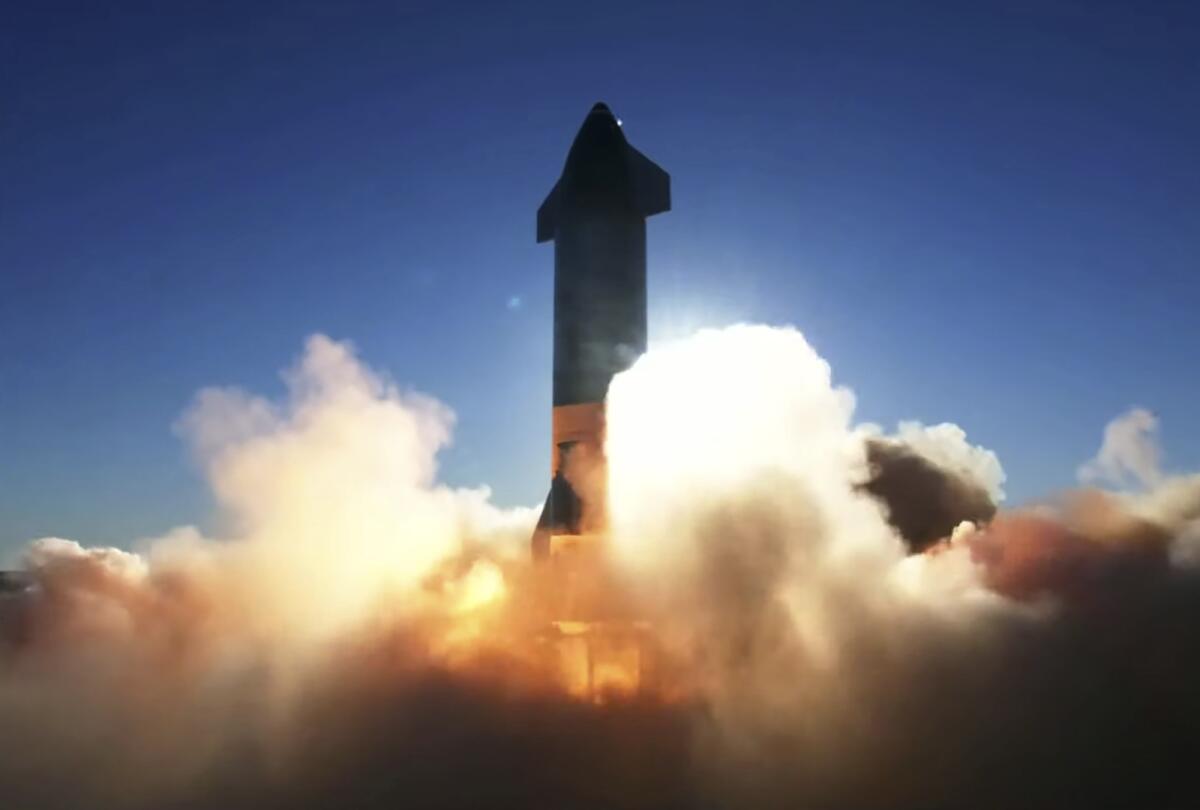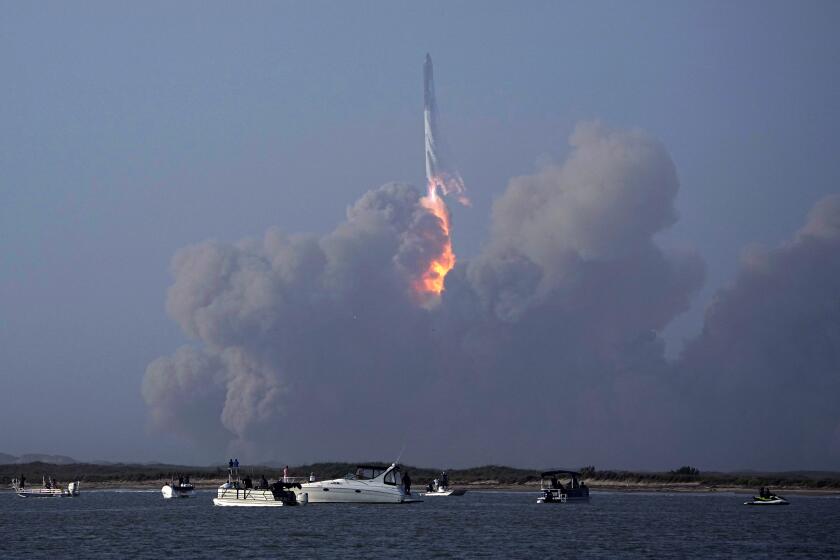SpaceX needs a stronger launchpad for next Starship launch

- Share via
Before SpaceX can try again to send its massive Starship rocket into orbit, the company needs to repair and renovate its badly damaged launch site in southern Texas.
It’s unclear whether the design changes that SpaceX is planning will be sufficient. The launch attempt April 20 destroyed the structure below the launchpad, sending chunks of sand, concrete and steel thousands of feet into the sky and setting fire to a nearby park.
To ensure that each subsequent flight doesn’t fling debris everywhere, the company is adding a new feature: a pair of massive steel plates with pressurized water to help dampen the effects of as many as 33 Raptor engines igniting during takeoff.
Industry experts aren’t sure that will be enough to prevent another “rock tornado,” the phrase Chief Executive Elon Musk used to describe the damaging combination of power, heat and gas that left a gigantic crater below Starship.
This was the first launch attempt of the company’s massive Starship moon rocket, which is crucial for the future of both SpaceX and U.S. plans for human space exploration.
When it comes to fire diversion and dampening tactics, the gold standard in the launch industry has been to build some kind of flame trench — a long, often V-shaped duct that helps redirect the massive energy and gas away from the launchpad and the rocket itself. Typically used in combination with a water-deluge system, it’s fairly standard infrastructure for practically any orbital rocket today — including rockets launched by SpaceX.
“It’s sort of astonishing to me that they didn’t use the practices that the launch industry has perfected for decades,” said George Sowers, a professor of mechanical engineering at the Colorado School of Mines who previously worked for Martin Marietta, Lockheed Martin and United Launch Alliance.
Whenever a rocket is ignited, scientists must account for a number of factors that can damage the rocket and surrounding area. The most obvious one is heat from the engines. Another is sound; the heightened acoustics of the engines produce a lot of energy. And a third, often overlooked, issue is fast-moving gas plumes generated by the engines.
SpaceX’s launch of its massive Starship rocket blasted concrete up to 6.5 miles away and resulted in more than 300 acres of debris, according to the U.S. Fish and Wildlife Service.
“It is thousands and thousands of pounds per second impacting on that concrete,” said Tory Bruno, CEO of United Launch Alliance, one of SpaceX’s competitors.
Gases generated by Starship are probably to blame for the debris from the test launch, Sowers said. The rocket took off from an elevated launch mount — a supersized milk stool — that stood over a slab of concrete.
Starship is designed to bring humans, including NASA astronauts, to deep-space destinations such as the moon and, eventually, Mars. SpaceX conducted its first test flight, which exploded shortly after liftoff, without a crew, but it has a contract with NASA to send astronauts to the moon later this decade.
When asked why SpaceX wasn’t considering adding a flame trench, Musk said in a Twitter Spaces conversation on April 29 that steel plates were another option and “we’re pretty confident this will work.”
The company didn’t immediately respond to requests for further comment on its plans.
SpaceX’s plan consists of two steel plates — the top one full of holes that will allow cold water to shoot out during launch, Musk said. The idea is that the steel will be able to withstand the intense forces and energy better than concrete, while the pressurized water will help additionally dampen the impact. Musk likened it to a “massive super strong steel shower head pointing up.”
“We’re putting down a very strong steel sandwich,” he said.
SpaceX was working on the steel plate structure ahead of Starship’s inaugural launch, but it wasn’t ready in time, Musk said. The company hadn’t anticipated how extensive the damage would be to the concrete on the Starship pad. “If we’d expected to dig a hole, we would not have launched,” he said.
Making a flame deflector out of steel and cooling it with water isn’t unprecedented, said Wayne Hale, an aerospace consultant and former manager of NASA’s space shuttle program.
“The geometry of it, exactly what it looks like, how big is it, how much water flow are they putting through it” — those are all questions that need to be decided, he said.
Due to the proximity of protected wetlands, SpaceX would need to file an application with the Army Corps of Engineers to modify its Starbase launch site with either a steel plate structure or a flame trench. The company hasn’t yet applied for any modifications to its permit, according to the corps.
Because Starship is so powerful, the heat transfer on the steel plate would be substantial, and the steel surface might melt during a launch. Refurbishment of the plate probably will be necessary between flights, though flame trenches often need refurbishment too.
“Clearly, they need to do something,” Hale said. “A repeat of this last event would not be good.”








